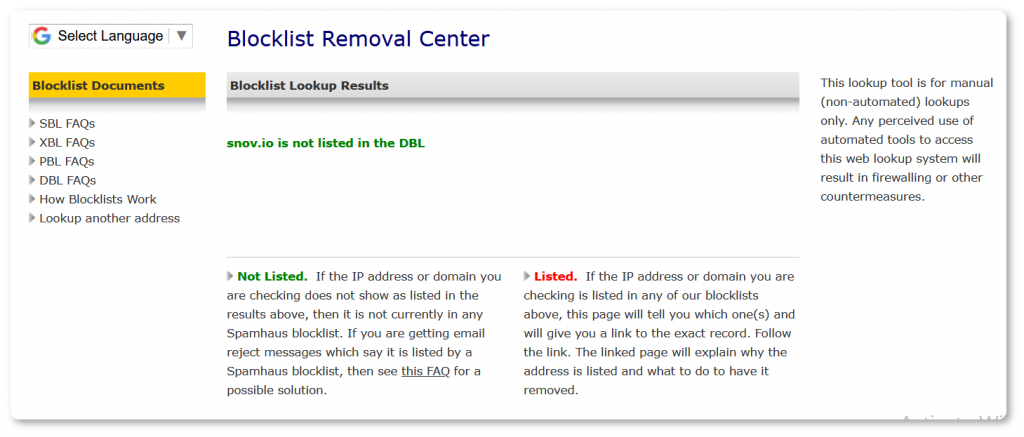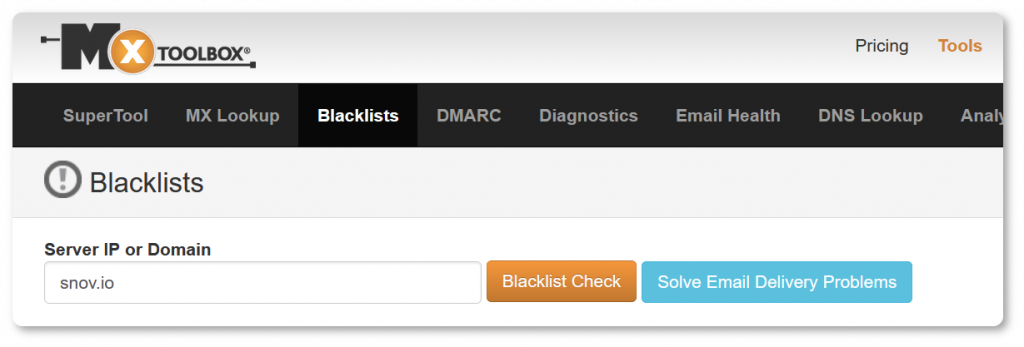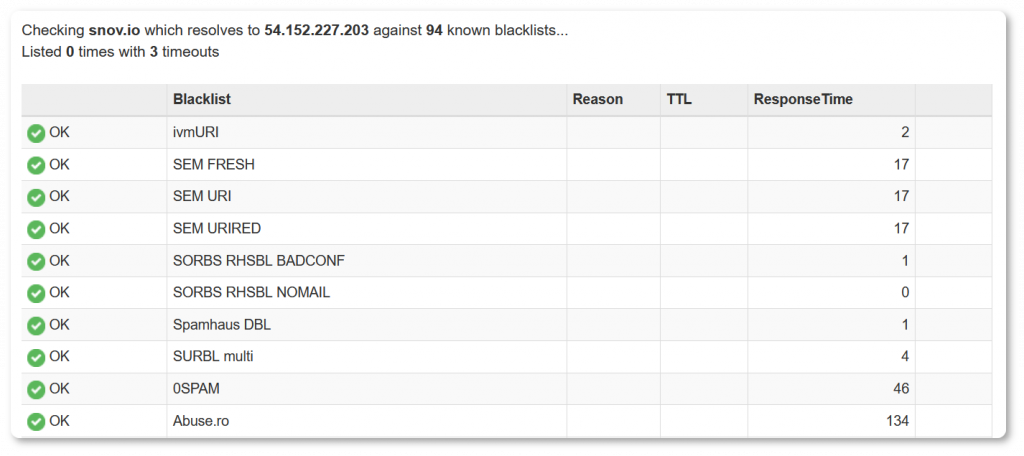Email blacklist
Are your mailings not reaching customers? Maybe it’s because your IP address or domain is blacklisted!
Every time you send a message, the recipient’s server checks your reputation. The essence of the test is to find out who you are and whether you can be trusted.
If the reputation of the IP address and domain is ruined, there are many complaints about sending spam, or there is an error in the DMARC policy settings, then your emails will end up in the spam folder or won’t reach the addressee at all.
Now let’s talk more about this topic.
What is an email blacklist?
An email blacklist is a database of domains and IP addresses blocked as suspected of spamming. Its purpose is to reduce the number of unwanted emails delivered to users.
An email blacklist can be private and public:
- Private. Most major ISPs, such as Gmail and Microsoft, have internal blacklists that are privately maintained. Having got onto this list, you won’t know you are on it until you receive bounces.
- Public. Unlike a private list, you can check if you’re on public blacklists directly and fix problems before you start sending emails.
How does a user get blacklisted?
There are many ways you can end up on an email blacklist:
- Receiving too many spam complaints from recipients.
- Sending emails to invalid addresses.
- Buying mailing lists.
- Falling into the spam trap.
- Using ESPs like Gmail to send bulk emails.
- Sending too many emails at the same time.
- Having the wrong DNS configuration.
If you recognize yourself in some of the above-mentioned actions, then you shouldn’t be surprised when your emails stop reaching your existing and potential customers. Don’t underestimate the problem.
Some service providers specifically launch robots to subscribe to the forms they find on the Internet and then check which mailings they receive. Blacklist companies have different determined standards for finding scammers but they mostly use a similar combination – data on spam complaints and spam traps.
Spam email complaints
Spam email complaints are used to identify senders that are guilty of sending out massive batches of emails. If the complaint rate is high, the IP address or domain is likely to end up on a blacklist.
To avoid this, you need to make sure that mailings are sent only to those addresses that are interested in your messages.
Spam traps
Spam traps look like real email addresses but don’t belong to real people. Used to find the sender of unwanted mailings, they are scattered across different websites.
There are two spam trap types:
Pure (or pristine) spam traps have never been used by anyone, which means they have never signed up for any email. They are placed on forums, contact pages, etc., with only one purpose — to catch spammers who collect addresses with email parsers. Any message sent to spam traps is automatically classified as spam.
Recycled spam traps are addresses that were once used by ordinary users but then were abandoned and became inactive. After a certain period of account inactivity (depending on the service provider), such an address is disabled and converted to a spam trap address. If you try sending an email to it, it will bounce.
For example, in Yahoo, this period takes at least a year. For other providers, it may be different:

Falling into this type of spam trap has a less negative impact. Still, it counts and adversely affects your reputation in general, as it tells the mail provider that you don’t monitor the quality of your database mailings if you send emails to non-existent mailboxes.
How to check if my email is blacklisted?
Okay, you know what an email blacklist is and how it works. Now it’s important to figure out how to check if you are not on it. Let’s start!
#1 – IP address and domain blacklist check with Spamhaus
You can check manually if you are included on various email blacklists such as SBL, XBL, PBL, DBL, and others. This can be done by entering your IP address and domain name on the Spamhaus website.
Let’s check Snov.io’s domain:

Not found!

Such a check can be also carried out on other blacklist checkers: Proofpoint, Barracuda, Cisco/Ironport, Invaluement, and Spamcop.
#2 – Check mail server blacklists with MXToolbox
MXToolbox is a powerful tool that can help you view the information in over 100 blacklists. Here’s what you need to do:
- Enter your server IP address or domain name.
- Click on the “Blacklist Check” button.

- Get the information you need.

Done! A green checkmark means that your server or domain is not found on the list.
Another good alternative to MXToolbox is UltraDNS.
What to do if your IP address or domain name is on the email blacklist?
Before proceeding to remove yourself from the list, make sure you’ve identified why you got on it and resolved all issues. You need to ensure you meet all the requirements for honest and transparent mailings by 110%.
Note! The first removal is usually simple and doesn’t bring any adverse consequences because companies are sympathetic to this situation. But if you are a repeat offender, antispam services may no longer want to remove your address from blacklists.
Email blacklist: removal from the blacklist using Spamhaus
Let’s see how the removal from Spamhaus is carried out. It’s considered one of the most serious and authoritative blacklists since it has a direct impact on the delivery of emails to a lot of domain names.
- Log in to the removal center, where you need to enter your domain or IP address. If you are an owner, then you should have already received the corresponding blocking notification.
- The notification will tell you what the problem is. Get busy fixing it. Let’s say the reason lies in an unauthorized mass mailing to a list of unverified addresses.
- Spamhaus suggests sending them an email explaining what happened, as well as a list of the steps taken to make the problem a thing of the past. The list of actions usually looks standard, e.g., “Now I use reCAPTCHA to prevent bots from subscribing to the newsletter;” “I use double opt-in to eliminate the risk of any unwanted subscriptions;” etc.
- After you send an email, the team will give an official answer within 24 hours. There can be two options: your address will be successfully removed from the blacklist, or they will send you the additional requirements that will need to be met for Spamhaus to fulfill your request.
How do you avoid email blacklisting?
Prevention is the best cure. Here’s what you can do to prevent your mail from being blacklisted:
- Only send emails to prospects that have explicitly permitted you to do so.
- Configure SPF record and DKIM in DNS.
- Make sure you have a valid PTR record that matches your outgoing public IP address and your mail server name (also, the hostname must match the same IP address).
- Enable SSL to encrypt the connection between the mail client and the server.
- Ask your customers to add your email address to their contact list.
- And, most importantly, make sure your prospect lists are verified and there are no untrusted email addresses in them.
Snov.io Email Verifier can help you with the last point. This tool allows both individual and bulk email validation. After verification, you’ll see three types of statuses – “valid,” “invalid,” and “unverifiable” (marked by green, yellow, and red colors).
Wrapping up
Blacklists are not there to make your life difficult but to ensure there is no abuse when sending emails to the masses. You must be 100% sure that you provide your leads with valuable content and don’t flood the inbox of those who haven’t even signed up to subscribe.
If you do everything right, without bypassing the rules, then your reputation is unlikely to suffer. You can read more about it in one of our blog posts.















